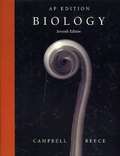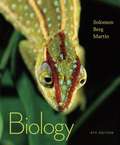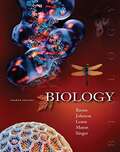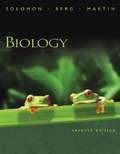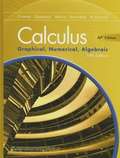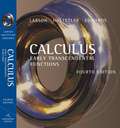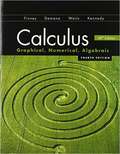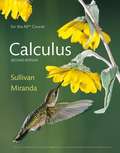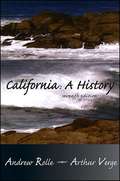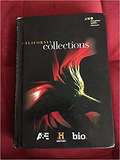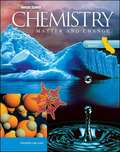Special Collections
District List: LAUSD High School Williams List of District Adopted and Approved Textbooks
- Table View
- List View
Biology
by Jane B. Reece and Neil A. CampbellThis special edition of Campbell/Reece BIOLOGY, Seventh Edition, is designed specifically for the Advanced Placement Biology community of teachers and students. The book's front section includes a few customized items specific to the needs of AP teachers and students.
Biology
by Linda R. Berg and Diana W. Martin and Eldra P. SolomonStudying biology in today's fast-paced environment where new research is cropping up daily is exciting--and also a bit daunting, unless you have the right textbook to help you make sense of it all. Popular with students at colleges nationwide, Solomon, Berg, and Martin's BIOLOGY is often described as the best text available for learning biology. Filled with resources to guide your study, the Eighth Edition brings clarity to key concepts as it draws you into the excitement of new research in genetics, cell communication, evolution, and many other topics. The book's in-chapter Learning System is like a built-in study guide, focusing your attention on key learning objectives. Many of the text's colorful illustrations are correlated with animated figures online so you can interactively study and reinforce your understanding of complex processes.
Biology
by George B. Johnson and Peter H. Ravenby Peter H Raven, George B Johnson, Kenneth A. Mason, Jonathan Losos, Susan Singer "Biology" focuses on evolution as a unifying theme. In revising the text, McGraw-Hill consulted with numerous users, noted experts and professors in the field. "Biology "is distinguished from other texts by its strong emphasis on natural selection and the evolutionary process that explains biodiversity. The new 8th edition continues that tradition and advances into modern biology by featuring the latest in cutting edge content reflective of the rapid advances in biology. That same modern perspective was brought into the completely new art program offering readers a dynamic, realistic, and accurate, visual program. AP Correlation Visit the Online Learning Center
Biology (7th edition)
by Linda R. Berg and Diana W. Martin and Eldra Pearl SolomonThis biology textbook covers topics such as the organization of life, energy transfer, genetics, evolution, diversity, structure and life processes in plants, structure and life processes in animals, and ecology. A companion CD-ROM contains practice tests, animation and video clips, and interactive tutorials. The authors teach biology at the University of South Florida, St. Petersburg College, and Rutgers University. Annotation ©2004 Book News, Inc. , Portland, OR (booknews. com)
Biology (California)
by Stephen Nowicki"The 21st century will be the century of biological science, just as the 20th century was the century of physical science," predicts Professor Stephen Nowicki, an award-winning teacher at Duke University. Dr. Nowicki has adapted his acclaimed introductory biology course for The Teaching Company to bring you up to date on one of the most important fields of knowledge of our time and help you appreciate the marvelous diversity and complexity of life. You will obtain the background and guidance to explore in depth the fundamental principles of how living things work-principles such as evolution by natural selection, the cellular structure of organisms, the DNA theory of inheritance, and much more. This challenging course is organized around three major themes: "Information and Evolution," "Development and Homeostasis," and "Energy and Resources." You will explore living systems at all levels, from biological molecules to global ecosystems. You will gain insight into pressing issues facing society, including genetic modification and cloning, stem-cell research, AIDS, the depletion of the rainforests, and global warming. You will discover mechanisms behind such intriguing phenomena as why children resemble their parents, why plants bend toward light, how memories are stored, why some birds have very long tails, and how life itself began on Earth. Above all, you will learn how to think about biology, so that in your day-to-day life you will understand the significance and complexities of news stories, medical issues, and public debates, not to mention what is going on in your own garden and in nature all around you.
Bridges to Literature (Grade 7, California Edition)
by Jane GreeneA literature book set according to California's education standards for grade 7 students.
Caesar
by Julius Caesar and Hans-Friedrich Mueller and Donald E. Sprague and Bridget S. DeanNIMAC-sourced textbook
Calculus
by Ron Larson and Robert Hostetler and Bruce H. EdwardsDesigned for the three-semester engineering calculus course, Calculus: Early Transcendental Functions, 4/e, continues to offer instructors and students innovative teaching and learning resources. Two primary objectives guided the authors in the revision of this book: to develop precise, readable materials for students that clearly define and demonstrate concepts and rules of calculus; and to design comprehensive teaching resources for instructors that employ proven pedagogical techniques and save time. The Larson/Hostetler/Edwards Calculus program offers a solution to address the needs of any calculus course and any level of calculus student. Every edition from the first to the fourth of Calculus: Early Transcendental Functions, 4/e has made the mastery of traditional calculus skills a priority, while embracing the best features of new technology and, when appropriate, calculus reform ideas. Now, the Fourth Edition is part of the first calculus program to offer algorithmic homework and testing created in Maple so that answers can be evaluated with complete mathematical accuracy.
Calculus
by Ross L. FinneyThis text, as the edition before it, was especially designed and written for teachers and students of Advanced Placement Calculus. Combining the scholarship of Ross Finney and Frank Demana, the technological expertise of Bert Waits, and the intimate knowledge of and experience with the Advanced Placement Program of Dan Kennedy, this text is truly unique among calculus texts. It may be used, in perfect order and without supplementation, from the first day of the course until the day of the AP* exam. Teachers who are new to teaching calculus, as well as those who are very experienced, will be amazed at the insightful and unique treatment of many topics.
Calculus
by Bert K. Waits and Daniel Kennedy and Franklin D. Demana and Ross L. FinneyThe esteemed author team is back with a fourth edition of Calculus: Graphing, Numerical, Algebraic written specifically for high school students and aligned to the guidelines of the AP Calculus exam. The new edition focuses on providing enhanced student and teacher support; for students, the authors added guidance on the appropriate use of graphing calculators and updated exercises to reflect current data. For teachers, the authors provide lesson plans, pacing guides, and point-of-need answers throughout the Teachers Edition and teaching resources. Learn more.
California
by Andrew Rolle and Arthur VergeSince its original publication, Andrew Rolle's classic work has been enjoyed by more than 100,000 persons, students and general readers alike. Like its predecessors, the seventh edition of California: A History recounts the state's history from its origins to the present in an engaging manner, while seeking a balance between conflicting viewpoints. Today especially, Californians face severe implications of the state's overwhelming diversity and continuing population explosion. This seventh edition incorporates these dramatic new developments in a historical context, pondering implications for the future. Likewise, those sections of the book devoted to women, the environment, immigration (legal and illegal), crime, sports, energy, and transportation have all been expanded. The most obvious change to this edition is the addition of Arthur Verge as coauthor, and loyal users will be delighted to see the addition of many new photographs that also help keep our "classic" text vibrant and current.
California Collections
by Houghton Mifflin HarcourtCalifornia Collections: A Grade 9 language arts textbook
Chemistry
by Theodore L. Brown and H. Eugene Lemay Jr. and Bruce E. BurstenThis is the tenth edition of a text that has enjoyed unprecedented success as an AP* program over its many editions. It is fair to ask why there needs to be yet another edition. The answer in part lies in the nature of chemistry itself, a dy¬namic science in a process of continual discovery. New research leads to new applications of chemistry in other fields of science and in technology. A text¬book that purports to introduce chemistry to AP* students who have only a limited prior acquaintance with it should reflect that dynamic, changing char¬acter.
Chemistry
by Laurel Dingrando and Nicholas Hainen and Kathleen TallmanMeets All California State Standards!Glencoe CaliforniaChemistry: Matter and Changecombines the elements students need to succeed! A comprehensive course of study designed for a first-year high school chemistry curriculum, this program incorporates features for strong math support and problem-solving development. Promote strong inquiry learning with a variety of in-text lab options, including Discovery Labs, MiniLabs, Problem-Solving Labs, and ChemLabs (large- and small-scale), in addition to Forensics, Probeware, Small-Scale, and Lab Manuals. Provide simple, inexpensive, safe chemistry activities with Try at Home labs. Unique to Glencoe, these labs are safe enough to be completed outside the classroom and are referenced in the appropriate chapters!
Chemistry
by Steven S. Zumdahl and Susan A. ZumdahlAuthors Steven and Susan Zumdahl offer all the elements instructors need for their general chemistry course. They bring a conceptual approach to chemistry and integrate problem-solving skills throughout, helping students transition from theory to practice. A strong emphasis on models, real-world applications, and visual learning prevails throughout the text. The Seventh Edition seamlessly integrates the strengths of the Zumdahl approach through a comprehensive and interwoven print and technology program. Enhanced Sample Exercises, online homework problems, and Classroom Response System content help instructors assess conceptual understanding and problem-solving skills, while new animations and images support visual learning. In addition, Houghton Mifflin offers implementation services through our TeamUP program to help instructors and students get the most out of the text and its supplements. New! Reality Checks at the end of selected Sample Exercises prompt students to ensure that their answers are reasonable. New! The expanded art program includes new electrostatic potential maps in Chapter 8, "Bonding" that illustrate bond and molecular polarity. New! The redesigned For Review section now includes bulleted key concepts for the chapter, as well as review questions of which approximately 50% are new. New! Integrative Problems in the end-of-chapter material assess students' cumulative understanding of multiple concepts and skills presented in previous chapters. End-of-chapter questions also include collaborative Active Learning Question (formerly In-Class Discussion Questions), Exercises organized by topic, Additional Exercises not keyed by topic, integrative Challenge Problems, and comprehensive Marathon Problems. New! Algorithmically-generated Test Questions as well as Conceptual Questions are available in HM Testing, all coded by level of difficulty to allow instructors to more easily choose appropriate test items. New! Animations with assignable exercises appear on the Online Study Center and Student CD. New! HM ClassPresent v.3 includes new animations and videos as well as enhanced search functionality. Eduspace Online Learning Tool features two kinds of problems: ChemWork interactive online homework and end-of-chapter algorithmic questions with links to corresponding textbook pages and media for student reference at point of learning.
Chemistry & Chemical Reactivity, Enhanced Review Edition
by John C. Kotz and Paul M. Treichel and Gabriela C. WeaverNIMAC-sourced textbook
